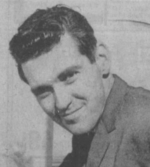 Unifax Photo, February 21, 1966. Convicted of the February 23, 1959 murder of 23-year-old National Airlines reservation clerk Mary Meslener in Dade County, Florida, and sentenced to life imprisonment, Joseph Francis Shea was exonerated in 1966 after spending seven years in prison as a result of several false confessions. Mary Meslener was shot to death in her car in the parking lot of Miami International Airport just after leaving her job on a winter evening in 1959. Her bloodstained car, which had been parked at the airport, was found abandoned in Tampa, and a fisherman and his wife found her body 30 hours later in the place where it had been dumped alongside the Miami Canal near Medley. Meslener had been shot once in the head. On May 18, 1959, Joseph Francis Shea, a 26-year-old airman third class at West Palm Beach Air Base, was arrested for Meslener’s murder after being coerced into a confession by interrogators. Shea’s first confession took place at the base when he pulled a bloodstained yellow sports shirt from a paper bag and declared to a nearby sergeant, “I must have done something bad in Miami.” After questioning Shea, Miami Detective Philip Thibedeau could find no connection between him and the murder. Even so, Detective Patrick Gallagher soon obtained Shea’s oral confession. The bloody shirt became the prime evidence against Shea. Shea was forced to take a lie detector test. Although he passed the test, he was told that he failed it. Later, two polygraph experts informed the agents of the State of Florida that they lied to him about the results of the tests before he confessed for a second time. Each of the confessions given by Shea, although materially different from each other, attempted to set forth in detail his actions during and after the murder. Although the prosecutors could not corroborate any of the facts in the confessions, they were able to convince the jury that the confessions were credible. Aside from the confessions, the only other evidence linking Shea to the crime was the shirt he was waving that belonged to him. At trial, the Dade County lab technician told the jury that it contained a large patch of Type O blood, which was the victim’s blood type. Shea’s blood was Type B. It was discovered later that the shirt was submitted for 25 different tests by at least four examiners, two of whom were leading specialists, and only one reported Type O blood found on a small area of the shirt. This finding was not made by either of the specialists. The State of Florida never revealed either to the counsel for the defense or the Circuit Court of Dade County the facts about the blood, or that there was evidence to indicate that a good deal of the Type B blood found on the shirt had been mechanically placed there. Prior to the original trial and conviction, authorities were aware that Shea clocked out of his job in West Palm Beach at 6:30 p.m. on the day in question, and that Meslener had left her job at Miami International Airport at 7:36 p.m. that same day. The time lapse of one hour and six minutes made it unlikely Shea had committed the crime, as it took two hours to drive to the airport from West Palm Beach and the crimes against Meslener appeared to have taken place as she got into her car after work. This timeline disparity was not disclosed to the defense. In addition, the State of Florida had found two other pieces of evidence that could not be connected to Shea: A palm print in the murder car did not belong to Shea, the victim, or the victim’s husband. The victim’s wallet was discovered in a military installation with which Shea had no connection. This evidence indicated that at least one or more individuals had knowledge about the facts of the case, and, thus, could have been a possible suspect. However, these facts were never made known to the defense or to the Circuit Court of Dade County. Shea was convicted on November 5, 1959 and sentenced to life imprisonment. Several years later, Miami Herald reporter Gene Miller began to reinvestigate the case. Miller was joined by polygraph technician Warren Holmes and by Detective Philip Thibedeau, who was an original investigator on the case. Together they convinced the court to give Shea a new trial based on the evidence which had not been originally revealed. As Holmes explained: “Shea was a neurotic, of low intelligence, who wanted to be punished. All the evidence was against him being the killer, but the authorities just didn’t want to know. Now we have forced them to admit there might have been a mistake.” At Shea’s retrial in February 1966, Shea’s attorneys were able to present new evidence not known to them at the first trial, including the fact that Shea had passed two polygraph exams and been lied to about the results and that most experts who had examined Shea’s shirt found no Type O blood. They also presented the timeline evidence that suggested Shea would not have had the necessary time to travel to Miami International Airport in time to commit the crime given the time he had left his job in West Palm Beach. At the close of Shea’s retrial, the jury acquitted him. The judge opined: “I have yet to hear any evidence against Shea. Is every man who ever confessed to be brought to trial without any corroborating evidence?” Shea was then released from the Florida State Mental Hospital, where he had served most of his time because he had suffered severe mental breakdowns. In July 1967, the Florida State Legislature awarded Shea $45,000 as compensation for his seven years of wrongful incarceration. – Isadora Blachman-Biatch and Dolores Kennedy
|